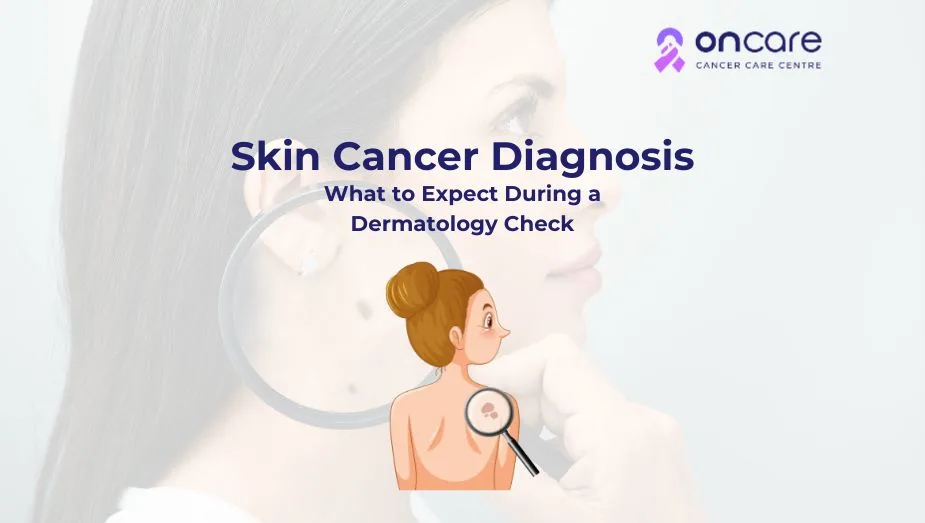Table of Contents
Skin Cancer Diagnosis: What to Expect During a Dermatology Check

Skin cancer is one of the most common cancers across the world. A regular dermatology checkup can save lives from cancer. Getting recommended for a skin cancer diagnosis can feel intimidating. Whether you have discovered a suspicious mole or just started to be conscious, a dermatology check-up is a great step towards prevention.
In this article, we’ll break down what to expect during a dermatologist checkup and tips to prepare for this procedure!
Skin Cancer Diagnosis Procedure: A step-by-step guide
The skin cancer diagnosis often starts with a physical examination of your skin. In most cases, healthcare professionals might remove some skin tissue to test it for cancer.
Step 1: Medical History review
In this step 1, your dermatologist might ask any of the symptoms which might confirm the suspicion of cancer.
Here are some of the questions they might ask you about to know more about your condition:
These may include:
- Personal and family history of cancer
- Sun exposure habits
- Use of tanning beds
- New moles
- Skin changes
- New skin lesions
Do not panic and be embarrassed, and try to be open and honest. Providing clear information can help the medical team to determine your risk level and survival rate and where to focus attention on your treatments, diet, and disease management.
Step 2: Full body skin examination
Performing a full-body skin examination is highly recommended because it offers a visual inspection of the suspected patient’s head to toe.
Your medical team might recommend you change into a comfortable gown. The dermatologist might use a bright light, and it is also called a dermatoscope.
This is a powerful tool helps to analyse:
- Scalp and face
- Neck, chest, and back
- Arms, legs, hand, and feet
- Fingernails, toenails, and between toes
- Underarms and buttocks
A dermatologist watches out for more asymmetrical moles, irregular borders, any type of color variation, or large spots on the body. All of these signs often point out skin cancer in suspected patients.
Step 3: Spot evaluation
If you discover a new mole that looks suspicious, then your dermatologist might photograph it for future studies and reference. There are many cancer clinics in India that offer digital dermoscopy to monitor changes over time.
An oncologist might explain why certain spots and moles are concerning using the ABCDE rule:
These may include:
Asymmetry: Irregular shape
Border: Irregular shaped edges
Color: Mole with more than one color
Diameter: Size larger than 6 millimeters
Evolution: Changing in shape, size or color
Step 4: Skin biopsy procedure
If any of the spots raises an alarming concern, the dermatologist might recommend a skin biopsy. This is a simple medical procedure.
These may include:
- The suspected skin or area will be numbed with a local anesthesia
- In some cases, a small (whole) portion of the skin gets removed
- Collected sample will often send to lab for further analysis
If you are advised to get a skin biopsy, you might feel a pinch or pressure, but mostly it would appear as painless. The biopsy results will usually come within 1 or 2 weeks.
What’s next if the results show skin cancer?
If your skin biopsy results show cancer, then your dermatologist might refer you to a cancer specialist for further treatments, and they will recommend the treatment plans for your fastest recovery.
The treatments will totally depend on the type and stage of cancer. In some cases, a skin biopsy alone can remove the tissue if it’s small and limited to the surface of the skin of a patient.
Here are some of the treatment options used for this disease.
These may include:
- Cryotherapy
- Excisional surgery
- Mohs surgery
- Chemotherapy
- Immunotherapy
- Radiation therapy
- Photodynamic therapy
Tips to prepare for your dermatology checkups
Here are a few tips to keep in mind when you are going for your dermatologist appointment especially for a skin cancer diagnosis.
These may include:
- Avoid wearing makeup
- Remove nail polish
- Wear comfortable and loose clothes
- Avoid wearing any moisturiser or lotions
- Analyse any new moles or spots in the body (list it for professional checkups)
- Be open and ready to communicate with your dermatologist
- Bring someone to accompany you to a checkups
Don’t be embarrassed to get a checkup with a dermatologist; understand that they are trained to help you and offer specialized treatments without having any judgments!
Why early detection matters!
Skin cancer, mainly including melanoma, basal cell carcinoma, and squamous cell carcinoma are highly treatable and manageable when detected in its early stages. Performing a regular skin examination by a dermatologist can detect any types of abnormalities while they become dangerous and incurable.
Studies have suggested that any unusual type of mole or spot can be a first sign of skin cancer, while an early diagnosis can be highly promising to prevent any fatal condition.
Consult Today
A dermatology checkup is a powerful defensive mechanism against a variety of cancers that affect the skin. A dermatology checkup is preventative and usually painless in nature. It often detects issues long before they become dangerous. Early detection is not just a smart way, but it’s often a life-saving decision.
At Oncare, we offer quality cancer treatments including advanced cancer surgeries at an affordable price range with an experienced cancer specialist consultation.
If you or any loved ones of yours are diagnosed with cancer then visit Oncare Cancer Center and book an appointment with our cancer specialist today. Get an estimated cost of your cancer treatments today!
Frequently Asked Questions
There are three main types of skin cancer.
These may include:
- Basal cell carcinoma
- Squamous cell carcinoma
- Melanoma
Some of these symptoms may include:
- Skin starts to look or appear as scars
- A flat, pink/red or brown - colored patch or bump
- Areas on the skin that look like scars
- Sores that looks crusty
- A wound or sore that won’t heal
- A wound that comes back again
- A rough, scale lesion that might itch, bleed, and become crusty
- A pearly or waxy bump on the face
Skin cancer looks different depending on the type of skin cancer a person has developed in their bodies.
The ABCDE rule to watch out for:
- Asymmetry: Irregular shape
- Border: Blurry or irregular shaped edges
- Color: Mole with more than one color
- Diameter: Larger than a pencil eraser
- Evolution: Enlarging
Here are some risk factors of skin cancer.
These may include:
- Excessive exposure to the sun
- An history of sun burn
- Tan or using tanning beds
- Having many moles
- Irregular shape of moles
- Having Actinic Keratosis
- Having a family history of cancer
- Taking medications that suppress the immune system
- Excessive exposure to the UV light

